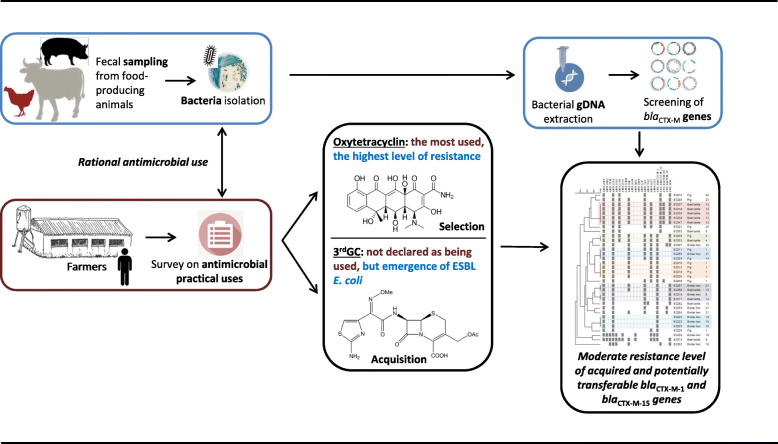- Record: found
- Abstract: found
- Article: found
Antimicrobial use and resistance in Escherichia coli from healthy food-producing animals in Guadeloupe

Read this article at
Abstract
Background
Selection pressure exerted by use of antibiotics in both human and veterinary medicine is responsible for increasing antimicrobial resistance (AMR). The objectives of this study were to better understand antimicrobial use in pigs, beef cattle, and poultry on farms on Guadeloupe, French West Indies, and to acquire data on AMR in Escherichia coli in these food-producing animals. A cross-sectional survey was conducted at 45 farms on Guadeloupe, and practical use of antimicrobials was documented in declarative interviews between March and July 2018. A total of 216 fecal samples were collected between January 2018 and May 2019, comprising 124 from pigs, 75 from beef cattle, and 17 from poultry litter. E. coli isolates were obtained for further testing by isolation and identification from field samples. Antimicrobial susceptibility testing and screening for bla CTX-M, bla TEM, tetA, and tetB resistance genes by polymerase chain reaction on extracted genomic DNA were performed.
Results
The study showed rational use of antimicrobials, consisting of occasional use for curative treatment by veterinary prescription. Tetracycline was the most commonly used antimicrobial, but its use was not correlated to E. coli resistance. Extended-spectrum β-lactamase (ESBL) E. coli isolates were detected in 7.3% of pigs, 14.7% of beef cattle, and 35.3% of poultry. bla CTX-M-1 was the predominant gene found in ESBL- E. coli isolates (68.8%), followed by bla CTX-M-15 (31.3%).
Related collections
Most cited references19
- Record: found
- Abstract: found
- Article: not found
Extended-Spectrum β-Lactamases: a Clinical Update
- Record: found
- Abstract: found
- Article: not found
Antimicrobial resistance: a global multifaceted phenomenon.
- Record: found
- Abstract: found
- Article: not found
